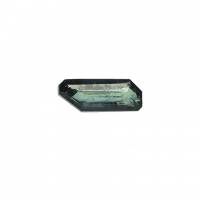Vivianite

Herja Mine, Baia Mare, Maramureș County, Romania
0.14 carats
© Brian Kosnar - Mineral Classics
Vivianite forms flattened prismatic transparent to translucent light green to deep blue or colourless crystals. It has very strong plechroism: deep blue - pale yellowish green - yellowish green.
Facetable crystals are rare.
| General Information | ||||||||||||||||||
|---|---|---|---|---|---|---|---|---|---|---|---|---|---|---|---|---|---|---|
| Chemical Formula |
| |||||||||||||||||
| Physical Properties of Vivianite | ||||||||||||||||||
| Mohs Hardness | 1.5 to 2, Gemstones of the world (2001) More from other references | |||||||||||||||||
| Specific Gravity | 2.64 to 2.70, Gemstones of the world (2001) More from other references | |||||||||||||||||
| Tenacity | Flexible, Handbook of mineralogy (2001) | |||||||||||||||||
| Cleavage Quality | Perfect, Gemmological Tables (2004) More from other references | |||||||||||||||||
| Light Sensitivity | Alters to blue or green on exposure to light, Gemmological Tables (2004) | |||||||||||||||||
| Optical Properties of Vivianite | ||||||||||||||||||
| Refractive Index | 1.560 to 1.640, Gemmological Tables (2004) More from other references | |||||||||||||||||
| Optical Character | Biaxial/+, Gemmological Tables (2004) More from other references | |||||||||||||||||
| Birefringence | 0.054 to 0.075, Gemmological Tables (2004) More from other references | |||||||||||||||||
| Pleochroism | Anomalous plechroism is strong with colours deep blue/pale yellowish green/yellowish green., Gems, Sixth Edition (2006) More from other references | |||||||||||||||||
| Dispersion | Weak, Handbook of mineralogy (2001) | |||||||||||||||||
| Colour | ||||||||||||||||||
| Colour (General) | Blue-green, deep blue, colourless, Gemstones of the world (2001) More from other references | |||||||||||||||||
| Transparency | Transparent,Translucent, Gemstones of the world (2001) More from other references | |||||||||||||||||
| Lustre | Vitreous,Pearly,Dull (Earthy), Handbook of mineralogy (2001) Pearly on the cleavage, dull when earthy. | |||||||||||||||||
| Crystallography of Vivianite | ||||||||||||||||||
| Crystal System | Monoclinic, Gemmological Tables (2004) More from other references | |||||||||||||||||
| Habit | Prismatic, Gems, Sixth Edition (2006) More from other references | |||||||||||||||||
| Geological Environment | ||||||||||||||||||
| Where found: | Vivianite occurs as a secondary mineral in the oxidized zone of metallic-ore deposits and in complex granite pegmatites., Gems, Sixth Edition (2006) More from other references | |||||||||||||||||
| Further Information | ||||||||||||||||||
| Mineral information: | Vivianite information at mindat.org | |||||||||||||||||
| Significant Gem Localities | ||||||||||||||||||
| ||||||||||||||||||
